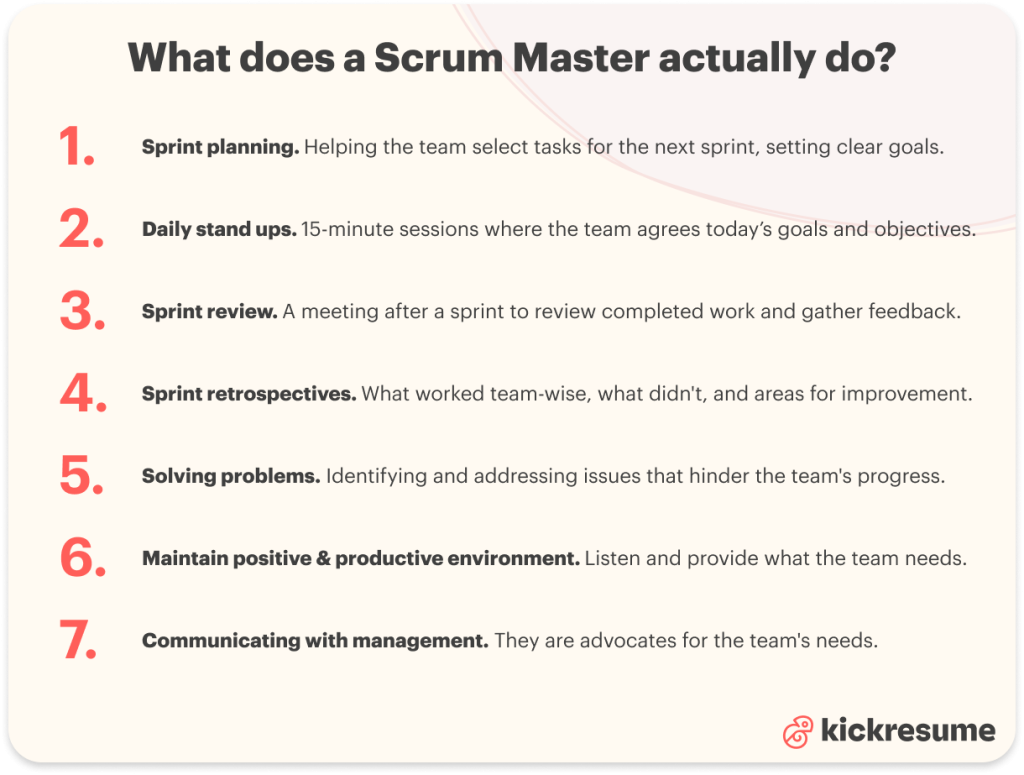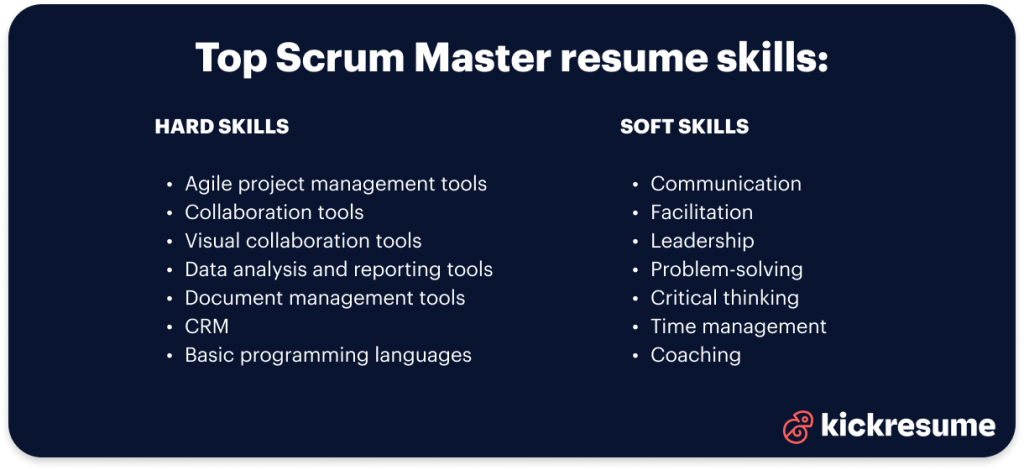If you're looking for a job or considering switching careers, today might be a good day to start thinking about how to become a Scrum Master.
Scrum Masters play a pivotal role in coordinating teams across different departments that work together on complex projects.
They help with establishing the right processes, team dynamic and workflow.
But to become a truly good Scrum Master, you'll need a delicate balance of hard and soft skills. Additionally, you might want to look into obtaining a specialized certification.
But we'll get to all that in due time.
If you'd like to learn about how to become a Scrum Master, read our article and find out:
- Who is a Scrum Master;
- How much does a Scrum Master earn;
- Who can become a Scrum Master;
- How to become one with no experience;
- How long does it take to become a Scrum Master;
- And, which courses & certifications to take.
- Who is a Scrum Master?
- Scrum Master vs. Project manager: Is there any difference?
- What is a Scrum Master's salary?
- Who can become a Scrum Master?
- How to become a Scrum master in 5 steps.
- How long does it take to become a Scrum Master?
- Online courses for Scrum Masters
- How to become a certified Scrum Master?
- Key takeaways: How to become a Scrum Master
Who is a Scrum Master?
In essence, a Scrum Master is a professional trained to oversee a team, which follows the SCRUM project management methodology, throughout the duration of a project.
If you've just read that sentence three times and you don't have the slightest idea what it means, don't worry.
Let's start with the basics.
What are Project Management Methodologies (PMMs)?
Every project that involves teams needs organization, communication and planning. Each member has to know what they're doing, why they are doing it, and when the task needs to be finished.
And to do that, you need to have a system that works.
We call these systems “project management methodologies” (PMMs).
Here are 5 of the most widely used PMMs:
- Waterfall. A traditional PMM that follows a linear, sequential approach. It moves through a project in a set of phases that flow downwards (like a waterfall). But this PMM is suited for projects with well-defined requirements and where changes are not expected.
- Agile. This PMM emphasizes flexibility, collaboration, and customer satisfaction. Agile breaks down projects into small, manageable units. And these can therefore be reassessed and changed anytime a project changes direction.
- Kanban. This one belongs under the umbrella of Agile. Kanban focuses on work visualization. Kanban boards are used to visualize the progress of tasks through different stages of project development.
- Lean. Lean aims to maximize value by minimizing waste. It focuses on delivering more value with less work by optimizing processes. But it's mostly used in manufacturing.
- Scrum. Scrum is focused on managing projects through short “sprint” approach. It’s ideal for small teams (max 10 people) and is often divided to two-week cycles with short daily meetings, known as daily scrum meetings.
What does a Scrum Master actually do?
Scrum master's main responsibilities involve:
- Sprint planning. During sprint planning meetings, the Scrum team picks which task from the product backlog will be dealt with in the next sprint. This helps ensure that everyone knows what the general direction is.
- Daily stand-ups. Then, they hold daily 15 minute sessions where team members agree on the day’s goals and objectives. They must keep everyone informed and on track
- Sprint review. The sprint review happens after a sprint ends. The team shows what they've completed. It's a chance to get feedback and make sure the work aligns with what's needed.
- Sprint retrospectives. This is a team meeting at the end of a sprint where everyone discusses what went well, what didn't, and how they can improve. The goal of these reflections is to help the team grow.
- Solving problems. Whenever issues pop up, the Scrum Master steps in to help find a way forward without giving direct orders.
- Maintaining a positive & productive environment. A key part of the this role is to ensure the team environment is positive and supportive. They listen and provide what the team needs to stay motivated and productive.
- Communicating with the management. Scrum Masters often act as a bridge between the team and higher management. They advocate for the team's needs and protect them from external pressures that might distract from their work.

Scrum Master vs. Project manager: Is there any difference?
Indeed, there is!
While project managers are more concerned with logistics, like observing deadlines, risks, managing the budget, and delivering concrete results, a Scrum Master focuses more on the ways in which the team functions.
Therefore, we could say that project managers are more oriented towards the results, and Scrum Masters are more oriented towards the team itself.
However, the role of a project manager is much broader in scope. Because project managers are expected to be able to handle more than just one project management methodologies. On the other hand, Scrum Master is expert only in one – SCRUM.
Because of the many similarities between the two roles, they often blend together.
What is a Scrum Master's salary?
According to a recent survey, 87% of companies that use Agile project management strategies prefer using Scrum over all other alternatives.
This means that Scrum Masters are currently in high demand.
But exactly how big a financial reward this profession can bring you depends on your location, experience, and individual employers.
For example, in the USA, the average Scrum Master can make approximately $108k per year.
If you're new to this, you can expect to receive $72k a year. And with just 1-3 years of experience (mind you, this is still an entry-level position), your salary can grow up to $102k per year.
Who can become a Scrum Master?
Now that you know what a Scrum Master does and how much they can make, you must be wondering “Do I have what it takes to become a Scrum Master?”
Well … let's find out!
Hard skills for Scrum Masters
Since the day to day tasks of a Scrum Master involve organizing meetings and keeping track of the team’s work and progress, you do need a few computer skills to feature on your resume:
- Agile project management tools (JIRA, Trello, Asana, or Azure DevOps)
- Collaboration tools (Slack, Microsoft Teams, or Zoom)
- Visual collaboration tools (such as Miro or Lucidchart)
- Data analysis and reporting tools (Power BI or Tableau)
- Document management and sharing tools (Microsoft Excel and Google Sheets)
- Customer Relationship Management Software (CRM)
- Basic knowledge of programming languages (Although not necessary, they can provide valuable insights, especially if you work in a tech oriented field.)
Soft skills for Scrum Masters
Agile processes are almost entirely dependent on team members and their collaboration, So, a Scrum Master must be a real people person. And with these soft skills under your belt, you can be a few steps closer to landing the job you want:
- Communication
- Facilitation
- Leadership
- Problem-solving
- Critical thinking
- Time management
- Coaching
If you need some help deciding how many skills to list on resume, we've thought about that too.

How to become a Scrum master in 5 steps.
The road to becoming a Scrum Master can be winding, but all the more rewarding!
And don't worry if you want to join the Scrum Master ranks without previous experience. After all, we all have to start somewhere.
Here's how to become a Scrum Master in 5 steps:
- Start by learning about the processes in other roles.
This step is especially useful if you know which industry you wish to apply to. Yes, you're not a Scrum Master yet, but you can start working on your skills right now. For example, take advantage of the position you are currently in and look at the teams around you. You can gain valuable insights by simply being in the middle of the “action”.
- Consider formal education.
Although Zippia shows that 66% of Scrum Master hold a bachelor’s degree and 26% hold a master’s, university credentials aren't needed to become one. But they can give you a solid leg up. This is especially true if you want to work in technical fields such as software development, information technologies and so on. In these cases, a degree can even be one of the main requirements.
- Enroll in courses of continuous learning.
Next, you can continue your journey by enrolling in courses focused on skills necessary for Scrum Masters. Starting small can be more sustainable if you currently have other commitments.
- Get certified.
And when you feel comfortable with your newly gained knowledge, it's time to get that Scrum Master certification. More on this subject in a later subchapter!
- Don't forget to update your resume.
Finally, before you begin your job search, make sure to add your new skills and certificates to your resume. And remember to always tailor your resume to a specific job posting!
How long does it take to become a Scrum Master?
Unfortunately, we can't say for certain. There are several factors that can influence the duration of your preparation, such as your starting point, whether you're currently working, or your ability to pick up new knowledge.
On average, Scrum Master certificates can take up around 16 hours. Which isn't all that much really.
But you also have to think about the time you'll have to spend self-studying and preparing for the final exam. All things considered, this preparation period can add weeks or even a month to the timeframe.
And maybe, after reading this article, you've realized that being a Scrum Master isn't the right choice for you. In that case, you can explore some other options:
For example, here's how you become:
Online courses for Scrum Masters
If you're starting from scratch, trying to figure out how to become a Scrum Master with no experience, start by enrolling into an online course.
Plus many certifications will require you to have pre existing knowledge to a certain extent. For example, they can ask you several basic questions about Agile methodologies to determine whether you're ready to begin the training.
We recommend enrolling into any of the following online courses:
#1 Introduction to Agile Development and Scrum
- Provider: IBM via Coursera
- Time: 9 hours (flexible schedule)
- Price: free
- About: Get started with using Agile Development and Scrum with this self-paced introductory course! After successfully completing this course, you will be able to embrace the Agile concepts of adaptive planning, iterative development, and continuous improvement - resulting in early deliveries and value to customers.
#2 How to create a Jira SCRUM project
- Provider: Coursera
- Time: 2 hours
- Price: free
- About: You will create a SCRUM project in Jira, exploring the SCRUM agile methodology and familiarizing with all of its elements. You will also create user stories and tasks, plan and action sprints, manage the backlog and sprints with the board, create epics, add dependencies and finally create burn-down charts to evaluate the progression of your sprints.
#3 Scrum Master Challenges & Solutions
- Provider: Udemy
- Time: 1 hour
- Price: free
- About: Each section features a challenge that you may face when implementing Scrum and discusses multiple solutions or ways to address it. Perfect if you are interested in upping your Scrum Master knowledge, starting the role, or furthering your training.
How to become a certified Scrum Master?
Lastly, when you're picking which Scrum Master certificate to enroll to, make sure the offer comes from a reputable source whose authority is recognized (preferably) worldwide.
- Provider: ScrumAlliance
- Time: approximately 14 hours
- Price: varies on location and form (live online or in-person)
- About: You'll learn the Scrum framework and gain an understanding of team accountabilities, events, and artifacts as well as how to guide your team to apply Scrum. CSM training gives you hands-on skills that you can immediately apply in the real world and expand your career opportunities.
In case you want to continue learning beyond this certificate, Scrum Alliance offers two more follow-up certification you can enroll in: Advanced Certified ScrumMaster® and Certified Scrum Professional® ScrumMaster.
#2 Professional Scrum Master™ Training
- Provider: Scrum.org
- Time: approximately 14 hours
- Price: TBA
- About: Professional Scrum Master™ (PSM) is an interactive, activity-based course. Through a combination of discussion and exercises, students develop a deep understanding of the underlying principles of Scrum and the Agile mindset while learning the practices applied by successful Scrum Teams. The course also includes a free attempt at the globally recognized Professional Scrum Master I (PSM I) certification exam.
Similarly, you can also continue upskilling with Scrum.org to the following: Professional Scrum Master™ Ⅱ Certification and, Professional Scrum Master ™ Ⅲ Certification.
Both certifications are widely recognized and respected in the industry. But their approach and examination process may differ.
Key takeaways: How to become a Scrum Master
In conclusion, becoming a Scrum Master seems to be a good career path for everyone who wants to make the project realization process run smoother and faster.
In short, Scum Masters break down large projects into smaller, more manageable tasks called sprints.
If you want to become a Scrum Master, know that you won't succeed overnight.
But following these 5 steps can bring you closer to your goal:
- Start by learning about the processes in other roles.
- Consider formal education.
- Enroll in courses of continuous learning.
- Get certified.
- Don't forget to update your resume.
In other words, becoming a Scrum Master is about stepping into the role of a facilitator and coach. Your role is to foster an environment where teams can thrive and deliver their best work.
FAQ: Scrum Master
- What does a Scrum Master do?
A Scrum Master overlooks teams that follow the Scrum project management methodology. S/he observes the processes within the Scrum team and suggests changes that can make the project realization run smoother and faster.
- How to become a certified Scrum Master?
The best way to become a Scrum Master is to obtain a certification from reputable institutions with international accreditation. For example: Scrum.org or the Scrum Alliance.
- Is a Scrum Master the same as a Project Manager?
No, it isn't! Both roles involve oversight of project tasks and team coordination. But while a Scrum Master only focuses on facilitating the Scrum process, a Project Manager typically has a broader role.
- What does a Scrum Master do all day?
A Scrum Master's day is filled by organizing daily stand-up meetings; analyzing and removing any impediments that slow down the team's work; coaches the team members when needed; and tries to create a positive and productive workplace environment.
- Can anyone become a Scrum Master?
Yes, anyone with an interest in Agile practices can become a Scrum Master. Although previous experience in project management or software development can be beneficial, it isn't necessary. Key qualities include good communication, and a collaborative mindset.
- How long does it take to become a certified Scrum Master?
It can vary. The certification course itself typically lasts for two days. But, the time spent on pre-course study, coupled with the exam preparation, can extend the total time by a few weeks or even a month.



